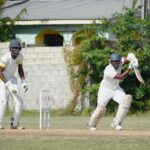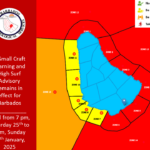I did not distinguish myself at Combermere School by being an athlete – I was terrible at sports. Fast-forward to last year when I realised that if I wanted to compete in running at the Olympics, then 2024 would likely be my last chance. So, after seeing Sada’s success, I decided to train for the 400 metres.
I started by investigating the times that former athletes who were past their prime currently run the 400. I decided that if I could not even run as fast as them, then my Olympic dream was dead. Former athletes’ times were reportedly between 60 and 90 seconds. I purchased some running shoes and a stopwatch, marked out 400 m on the pavement and ran.
The dream
My running time was 86 seconds – but at the end, I saw those black stars and felt that I would get a heart attack if I took one more step. I tried one week later and it took me over 90 seconds, so I accepted that my Olympic dream had come to an end. Then I read Born to Run and it changed my life.
There is an indigenous tribe of Indians in Mexico called Rarámuri (also known as the Tarahumara) who do not suffer from the modern health ailments of heart disease, diabetes and cancer. They eat mainly a plant-based diet. They also run over 100 kilometres at one time in sandals without injuries – by running lightly on the front of their feet (not their heels). So, I ordered similar sandals from Xero Shoes.
Our amazing feet
Our feet contain almost one-quarter of the bones in our bodies (52 of the 206) and over 200 muscles, tendons and ligaments. With so many movement joints, our feet seem designed for complex movements when we run. This complex movement is observed. For example, when persons run barefoot their toes tend to flare out before resting on the ground.
Housing our feet in shoes does not allow this toe-flaring, and the padded support in our shoes limits the use of many muscles in our feet leading to their weakening. Running in flat flexible sandals protects the soles of our feet from sharp debris on the ground while allowing our toes to naturally flare.
The test
While waiting for my sandals to arrive, I started walking around our house barefoot and keeping my heels off the ground when I was walking or standing. Within one month I had noticeably stronger feet and legs.
When my sandals arrived, I ran like the Rarámuri. When I reached 400 m, I anticipated that I would be too exhausted to continue, but I was not tired. I ran 1.4 km, which is the most I have ever run in my life. Since I was still not exhausted, I ran a further 1.4 km. However, I felt a sharp pain in my calf so I stopped running.
The pain continued for one week and stopped. When it stopped, I resumed running and ran for 1.4 km before feeling that familiar pain in my calf. However, it went away after a few hours and has not returned to this day.
Timing myself
I decided to start timing myself, so the next week I ran four km in a circuit that included an 81 m incline. My average time per km was 7 minutes 58 seconds. The next week, I ran three km around the Garrison and my average time per km was 6 mins 51 secs. The next week I ran two km and my average time per km was 5 mins 36 secs. However, I realised that my aim had shifted from running well to running fast, so I had to reset. My current plan is to run well for 30 minutes regardless of how far that takes me.
I believe that we were born to do many other things besides running, but I believe that our feet were designed for running. The book summarised the Rarámuri’s running method in four steps: easy, light, smooth and fast. I will describe these steps and include my own based on my recent experience and advice from my brother – who also runs.
Running well
The first step is to run easy, at a pace where you can carry on a conversation. If you cannot run and talk, then you are running too fast and using too much energy to sustain running long distances – so you may get too exhausted to continue.
The second step is to run lightly on the front of your feet, and use short strides so that your foot never lands in front of your knee (therefore, your leg is never straight) – this should minimize the impact force of your foot on the ground, which should minimize running injuries. You should also run erect.
The third step is to breathe deeply since oxygen is like fuel for your leg muscles. The longer you run, the more frequently you may need to take deep breaths to sustain your running. You should also take coconut water with you and drink when you feel thirsty.
The fourth step is to do all of the previous steps smoothly. Therefore, as you run, keep checking that you are doing all the previous steps and correct yourself as necessary. As you keep running smoothly, you should automatically run faster. However, do not aim to run fast but to run well.
My best advice
I look forward to my weekly runs, after which I give my body one week to recover. If you plan to run then I suggest the following: get medical advice from your doctor; eat a diverse plant-based diet; spend at least one month walking and standing while keeping your heels off the floor to strengthen your feet before running in sandals; run easy, light and smooth while breathing deeply and running erect; take water with you while you run, and stop if you feel any pain and seek medical advice.
If you are taking drugs that reduce the density of your bones, then you need to consult with your doctor and investigate natural alternatives that do not have this damaging side effect.
Grenville Phillips II is a Doctor of Engineering and a chartered structural engineer.
The post To run and not grow weary appeared first on Barbados Today.


